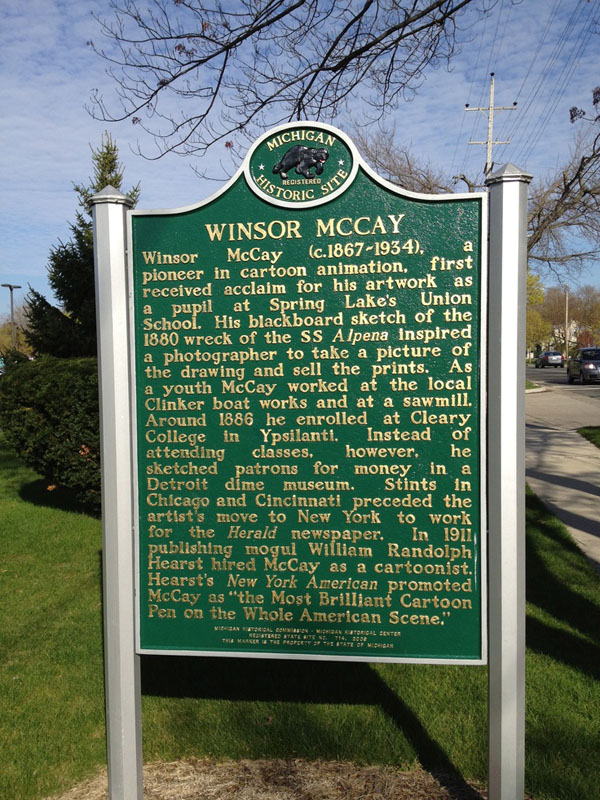
The Winsor McCay Historical Marker situated on McCay Park in Spring Lake, Michigan.
A typical Wednesday, once a month, I drive over a bridge and journey three miles from my hometown of Grand Haven, Michigan. The destination: Spring Lake District Library.

Aerial view of Spring Lake District Library relative to where McCay’s school and home (outlined in red) once stood. The blue “X” marks the location of the Winsor McCay Historical Marker. Clic to enlarge.
I close my eyes and the wooden schoolhouse appears in my mind. I’m in the classroom of 13-year-old Winsor McCay. It’s the final days of October, 1880. I say, “Hello,” to his 22-year-old teacher, Hattie Schofield. Aside from being an educator, she’s a portrait artist. I tell her I’m just there to watch, and she escorts me to the back of the classroom.
She’s given young Winsor McCay permission to draw a picture on the classroom blackboard. He is allowed to use the entire chalkboard as his canvas. McCay begins creating an illustration of a steamship that left the area port several days ago and sank during an enormous storm on Lake Michigan. The ship went down with all 80 on board.
I open my eyes, the park returns. The school is no more. I walk into the library for our scheduled Winsor McCay Committee meeting. We’re going over development plans for the park. Back in 2008, we scored our first victory securing a State of Michigan historical marker designating Spring Lake as Winsor McCay’s hometown.

Kevin Collier reads a letter from the grandson of Winsor McCay at the dedication of the historical marker, 2008.
Children here today learn about McCay at an early age. Many families attend the annual McCay Day hosted at the library. And on September 26th, 2017, the library will be placing on display a photograph that was taken 137 years ago, of McCay’s The Sinking of The Alpena illustration.
The chalk was wiped away, but before it was, a photographer came into the classroom and took a sharp photo of Winsor’s drawing. He sold prints of the picture, giving McCay a cut. Thus, it became Winsor McCay’s first commercial illustration. It also compelled him to imagine, “I can make money with my drawing.”
The new book from Cartoon Research – Winsor McCay’s The Sinking of The Alpena – brings that 1880 photograph back to life. Long before McCay’s famous “Sinking of The Lusitania” cartoon, another ship went down that started his professional career.
 Two original prints struck from the negative at the time exist today. Both are in the possession of Ottawa County’s Tri-Cities Historical Museum. They didn’t even know what they had until we went looking for it. It was indexed as “Alpena Sinking Photo.” McCay was a kid at the time, not a famous cartoonist. The photo was filed away and forgotten.
Two original prints struck from the negative at the time exist today. Both are in the possession of Ottawa County’s Tri-Cities Historical Museum. They didn’t even know what they had until we went looking for it. It was indexed as “Alpena Sinking Photo.” McCay was a kid at the time, not a famous cartoonist. The photo was filed away and forgotten.
You can feel McCay’s presence here, but most treat it as what it is, “local history.” A snapshot of 18 years at the beginning of his life. Blame the 1870 census taker, Gaines M. Barney, for creating confusion concerning Winsor’s age. He “rounded up” McCay’s age to 3 when he stopped at his home August 16th, 1870. McCay wouldn’t be 3 until September, but that was the routine Barney played, rounding up children’s ages if their birthdays were in 3 months, or less.
The McCay home is long gone, but it stood only a block away from the library. And there is a search going on through 1870-80 era textbooks used at Union School. McCay drew pictures in them, and we expect to find some containing his art one day.
The Sinking of The Alpena was a game-changer for Winsor McCay. The recognition it received locally certainly raised his confidence level and paved the way for a career in illustration. For more information about this incredible image and the full story behind it… click here.









































I’m glad to see Cartoon Research is coming along with their e-book series. I never knew about McCay’s first commercial drawing when he was still a teen.
Added this to McCay’s Wikipedia entry for further reading